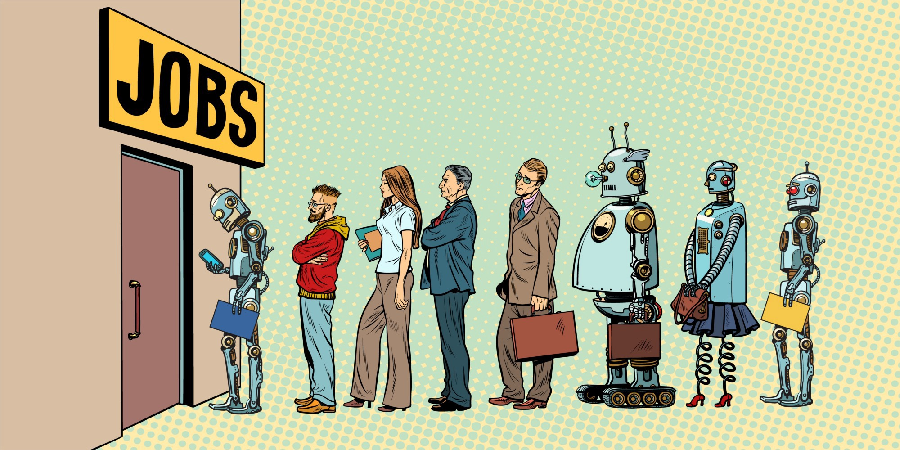Applications of AI in the Workforce

From Competition of people and robots for jobs by studiostoks 2018, https://www.shutterstock.com/image-vector/competition-people-robots-jobs-technological-revolution-1006220329?irgwc=1&utm_medium=Affiliate&utm_campaign=TinEye&utm_source=77643&utm_term=, CC BY
AI's applications, relating to the workforce, can be observed in the following areas:
- Current applications of AI in the workforce
- Future applications of AI in the workforce
- Deep Learning applications
- AI applications in creative sectors of work
Current applications of AI in the workforce
Martin Ford (as sited in Tesse 2015) states that a forty two percent increase in the American labour market output is not the product of humans but rather the automation of jobs. The dwindling demand for humans in the workforce is derivative of current implementations of ML. The e-commerce marketplace Amazon has prioritized ML and robots over human based labour in company owned warehouses, specifically regarding picking and packing of goods processes (Estlund 2018).
Future Applications of AI in the workforce
Brynijolfsson and Mitchell (2017) state that AI can strategize more efficiently than humans in identifying regularities in statistics and large data sets. Furthermore, these systems can be implemented in appropriate sectors of work such as, the relevant classification of case documents in law firms, and analysing medical images in hospitals.
Jordan and Mitchell (2015) put forth the idea that utilizing AI’s ability to process large amounts of data, an infectious disease risk prevention system could be implemented, by-way of online location and medical data.
Deep Learning Applications
DL out performs other ML techniques in, but not limited to, analysing particle accelerator data, reconstructing brain circuits, and delivering prognoses in medical fields (Lecun et al. 2015).
Predictions of American socioeconomic traits, including voting inclinations, can be accurately derived, utilizing DL in conjunction with Google street view. Identifying a prevalence of sedans over pickup trucks, observed through google street view, indicates an eighty-eight percent chance of a city harbouring Democratic inclination (Gebru et al. 2017). Future instalments of DL can potentially save government spending’s on surveys, opting for DL systems instead.
AI and creative sectors of work
Currently, there are machine learning algorithms that successfully identify objects utilizing neural networks. However, reversing this system, so that what is known is transferred through DL algorithms, generates a collage of the object; an observable AI based interpretation of an object is produced. Moreover, these techniques of reversing trained neural networks present in DL systems are reproducible in other artistic mediums, such as poetry ( Arcas 2016).
Toivonen and Gross (2015) cite the use of artificial neural networks in the generation of stew recipes by the learning algorithm PIERRE.
Miroshnichenko (2018) states that AI threatens the journalistic sect of media by replacing the creative human practice that is journalism with news-writing algorithms. Miroshnichenko further states that AI’s implementation is imminent, illustrated by the one and a half billion news stories conceived in the year 2016 by Wordsmith, a news-writing algorithm.